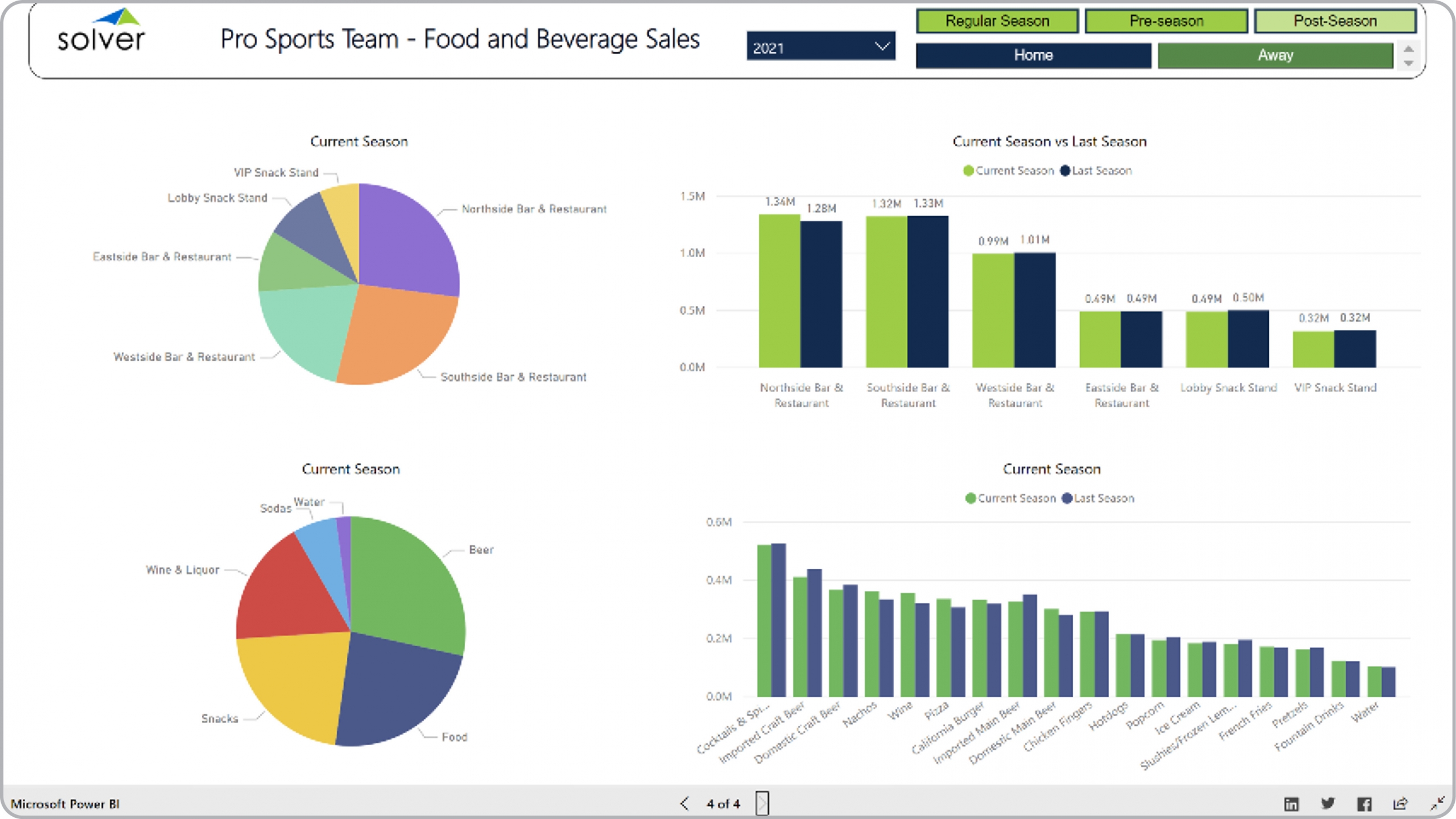Food and Beverage Sales Dashboard for Professional Sports Organizations
What is a
Food and Beverage Sales Dashboard
? Food & Beverage (F&B) Dashboards are considered sales analysis tools and are used by Finance teams and F&B managers to analyze sales by location and F&B category. Some of the main functionality in this type of dashboard is that it enables comparative analysis from four different perspectives: 1) Current season F&B sales by location (i.e. restaurant or stand), 2) Current season ranked sales by food or beverage category, 3) Current season versus last season sales by F&B location, and 4) Current season versus last season ranked sales by F&B category. Using the filters on the top of the screen, the user can filter by year, regular season/pre-season/post-season as well as Home/Away games. You find an example of this type of dashboard below.
Purpose of
Food & Beverage Sales Dashboards Professional sports organizations use Food & Beverage Sales Dashboards to gives managers a clear and simple way to monitor revenues from the restaurants and stands at their venue. When used as part of good business practices in Financial Planning & Analysis (FP&A) and F&B departments, an organization can improve its revenues, and it can reduce the chances that underperforming locations or F&B items are not quickly detected and reviewed.
Example of a
Food & Beverage Sales Dashboard Here is an example of a Food & Beverage Dashboard with location and category comparisons.
 You can find hundreds of additional examples
here
Who Uses This Type of
Dashboard
? The typical users of this type of dashboard are: Team owners, venue managers, CFOs, F&B Managers.
Other Reports Often Used in Conjunction with
Food & Beverage Sales Dashboards Progressive Financial Planning & Analysis (FP&A) and F&B departments sometimes use several different Food & Beverage Sales Dashboards, along with profit & loss reports, annual budgets, sales forecasts, revenue dashboards, detailed food & beverage sales reports and other management and control tools.
Where Does the Data for Analysis Originate From? The Actual (historical transactions) data typically comes from enterprise resource planning (ERP) systems like: Microsoft Dynamics 365 (D365) Finance, Microsoft Dynamics 365 Business Central (D365 BC), Microsoft Dynamics AX, Microsoft Dynamics NAV, Microsoft Dynamics GP, Microsoft Dynamics SL, Sage Intacct, Sage 100, Sage 300, Sage 500, Sage X3, SAP Business One, SAP ByDesign, Acumatica, Netsuite and others. In analyses where budgets or forecasts are used, the planning data most often originates from in-house Excel spreadsheet models or from professional corporate performance management (CPM/EPM) solutions.
What Tools are Typically used for Reporting, Planning and Dashboards? Examples of business software used with the data and ERPs mentioned above are:
You can find hundreds of additional examples
here
Who Uses This Type of
Dashboard
? The typical users of this type of dashboard are: Team owners, venue managers, CFOs, F&B Managers.
Other Reports Often Used in Conjunction with
Food & Beverage Sales Dashboards Progressive Financial Planning & Analysis (FP&A) and F&B departments sometimes use several different Food & Beverage Sales Dashboards, along with profit & loss reports, annual budgets, sales forecasts, revenue dashboards, detailed food & beverage sales reports and other management and control tools.
Where Does the Data for Analysis Originate From? The Actual (historical transactions) data typically comes from enterprise resource planning (ERP) systems like: Microsoft Dynamics 365 (D365) Finance, Microsoft Dynamics 365 Business Central (D365 BC), Microsoft Dynamics AX, Microsoft Dynamics NAV, Microsoft Dynamics GP, Microsoft Dynamics SL, Sage Intacct, Sage 100, Sage 300, Sage 500, Sage X3, SAP Business One, SAP ByDesign, Acumatica, Netsuite and others. In analyses where budgets or forecasts are used, the planning data most often originates from in-house Excel spreadsheet models or from professional corporate performance management (CPM/EPM) solutions.
What Tools are Typically used for Reporting, Planning and Dashboards? Examples of business software used with the data and ERPs mentioned above are:
- Native ERP report writers and query tools
- Spreadsheets (for example Microsoft Excel)
- Corporate Performance Management (CPM) tools (for example Solver)
- Dashboards (for example Microsoft Power BI and Tableau)
Corporate Performance Management (CPM) Cloud Solutions and More Examples
April 25, 2021
TAGS:
Reporting,
Solver,
sports dashboard,
report writer,
Microsoft,
template,
practice,
Acumatica,
visualization,
Netsuite,
Finance,
planning,
GP,
dashboard,
Business Central,
excel,
food,
beverage,
ax,
Sports,
forecast,
Budget,
pro sports,
Dynamics 365,
budgeting,
professional sports,
stadium,
revenue,
Cloud,
Software,
Tableau,
SAP,
example,
best,
Sage,
BC,
location,
D365,
NAV,
Intacct,
CPM,
report,
SL,
Management,
dynamics,
sales,
Power BI,
food and beverage dashboard,
food and beverage

 You can find hundreds of additional examples
You can find hundreds of additional examples